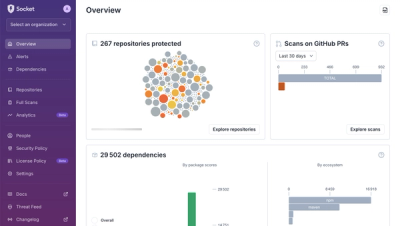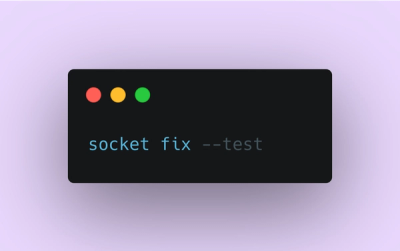
Research
Using Trusted Protocols Against You: Gmail as a C2 Mechanism
Socket uncovers malicious packages on PyPI using Gmail's SMTP protocol for command and control (C2) to exfiltrate data and execute commands.
aws_gw_lambda_simulator
Advanced tools
## Summary A basic simulator of AWS API Gateway and Lambda runtime, intended to help in developing and debugging Node-based Lambdas for use in AWS. Can this be used as a production scaffold? Probably. But it was written specifically to help develop Lam
A basic simulator of AWS API Gateway and Lambda runtime, intended to help in developing and debugging Node-based Lambdas for use in AWS. Can this be used as a production scaffold? Probably. But it was written specifically to help develop Lambdas.
Because we want to write and debug Lambdas ... but we didn't find an easy-to-use, reusable scaffold that worked for us. aws sam local, serverless, and others ... none worked the way we liked. So we wrote this.
npm install aws_gw_lambda_simulator
Here's an example of basic usage in Node. After launching the application, point your browser to http://localhost:3000/echo, assuming you have a Lambda called echo in the same folder as your program entry point, and watch your Lambda run.
const API_GW = require('aws_gw_lambda_simulator');
let server = new API_GW.Server();
let routes = [
{ verb: "GET", filepath: __dirname + '/echo', route: '/echo' }
];
server.config(routes);
server.listen(3000, () => {
console.log('started on 3000 from js');
});
Prefer TypeScript? So do we! Here's the same example in TypeScript:
import { Server, HTTP_VERB, lambdaRoute } from 'aws_gw_lambda_simulator';
let server = new Server();
let routes: Array<lambdaRoute> = [
{ verb: HTTP_VERB.GET, filepath: __dirname + '/echo', route: '/echo' }
];
server.config(routes);
server.listen(3000, () => {
console.log('started on 3000 from ts');
});
Concerned about CORS restrictions? Under the hood we use the cors module to handle this. Simply pass in a CORS configuration object as the optional second parameter to config. For example:
// enable cors
let cors = {
origin: true,
methods: 'GET,HEAD,PUT,PATCH,POST,DELETE',
credentials: true,
exposedHeaders: ['x-auth-token']
};
server.config(routes, cors);
URL Parameters are supported. Simply include the name of the parameter in typical express-style notation, rather than the AWS-style bracked {} notation. For example:
let routes = [
{ verb: "GET", filepath: __dirname + '/echo', route: '/echo/:id' }
];
The value of :id will be supplied in event.pathParameters.id, just as they would in the proper AWS environment. For example, if the the above route definition calls the echo sample lambda shown below, and a request comes in for http://localhost:9999/echo/abc (where your server is running on port 9999 on localhost), the result will be something like:
{
"event": {
"resource": "/echo/:id",
"path": "/echo/abc",
"queryStringParameters": null,
"pathParameters": {
"id": "abc"
},
"httpMethod": "GET",
"headers": {
"cache-control": "no-cache",
"accept": "*/*",
"host": "localhost:9999",
"accept-encoding": "gzip, deflate",
"connection": "keep-alive"
},
"body": {}
},
"context": {}
}
Obviously, there are countless ways of accomplishing the same task when it comes to coding. What we tend to do is:
npm initHere's a sample lambda function. Note the use of (exports || module.exports).handler for the entrypoint - this allows
the lambda to run unmodified both locally and in AWS' environment (AWS directly exposes the exports object, which Node
typically doesn't do).
(exports || module.exports).handler = (event, context, callback) => {
return callback(null, {
statusCode: 200,
body: { event, context }
});
};
aws_gw_lambda_simulator uses express to spin up a web server. You pass in an array of routes to expose, as well as optional CORS configuration as described above. It passes in mock objects that stand in for the event, context, and callback values. These are not 100% accurate representations of the objects you'll be provided in the true AWS Lambda environment. Rather, they contain a subset of those fields that have thus far been necessary for our development.
The config method requires an array of lambdaRoutes. Each one of these must contain exactly 3 properties:
verb - this is the HTTP verb to listen for. Currently, GET, POST, PUT, DELETE, PATCH, OPTIONS, and HEAD are supported. If using TypeScript, you can use the enum HTTP_VERB to access the possible values (ex: HTTP_VERB.GET or HTTP_VERB.POST). Otherwise, use the name of the verb (ex: "GET" or "POST").filepath - the path to the entry point file for your Lambda. Since this file gets loaded via require, you don't need to include the trailing '.js' if you don't want to. You must specify the full path or use __dirname to ensure the correct path is used to locate the lambda entry point. Otherwise, it will attempt to load the file using the node_modules subfolder as the starting point, and will lead you to unexpected results.route - the URL path to expose the endpoint as.Each lambdaRoute may optionally contain an options object of type gwOptions. Presently it supports:
x_api_key - an optional string value to be required to simulate the API Key functionality of API Gateway. When a value is supplied, the exact value must be provided by the caller of the web service in the header x-api-key. If x-api-key is either not provided, or is not the same value specified in the x_api_key property, the framework will not execute your lambda, and instead return a 403 error, along with the simple payload of "Forbidden". Keep in mind, the scaffold spins up an unencrypted HTTP site, not one protected by HTTPS, so do not use this key to protect services without using an external HTTPS endpoint to proxy the request - otherwise your x-api-key could be read by network sniffers.tokenAuthorizer - an optional object that can specify an "authorizer" lambda. See below for more information. A valid tokenAuthorizer consists of two values:
filepath - the path to the entry point file for your Lambda. This field operates exactly the same way as the filepath field to the target lambda operates.header_key - the name of the http header that is expected to contain the authorization token. This will be passed into the authorizer lambda event object as authorizationToken, just like in the real AWS environment.Authorization lambdas need to be written and debugged, too! Hence the limited ability for aws_gw_lambda_simulator to run authorization lambdas. Since this framework is meant as a development tool, some pretty serious limitations exist. See the section on Limitations, below.
Here's a sample authorization lambda written in TypeScript.
(exports || module.exports).handler = function(event: AWSLambda.CustomAuthorizerEvent, context: AWSLambda.Context, callback: AWSLambda.Callback) {
let authorizationToken = event.authorizationToken;
let success : boolean;
// Do some processing on authorizationToken
if (success)
{
// successfully validated client.
return callback(null, generatePolicy(id, 'Allow', "arn:aws:execute-api:{regionId}:{accountId}:{appId}/{stage}/{httpVerb}/[{resource}/[child-resources]]"));
}
else
{
// invalid ... deny deny deny!
return callback(null, generatePolicy(id, 'Deny', "arn:aws:execute-api:{regionId}:{accountId}:{appId}/{stage}/{httpVerb}/[{resource}/[child-resources]]"));
}
};
// Helper function to generate an IAM policy
function generatePolicy(principalId : string, effect : string, resource : string) {
var authResponse : AWSLambda.AuthResponse = {
principalId, policyDocument : undefined
};
if (effect && resource) {
var policyDocument : AWSLambda.PolicyDocument = {
Version : '2012-10-17',
Statement : []
};
policyDocument.Version = '2012-10-17';
policyDocument.Statement = [];
var statementOne : AWSLambda.Statement = {
Action : 'execute-api:Invoke',
Effect : effect,
Resource : resource
}
policyDocument.Statement[0] = statementOne;
authResponse.policyDocument = policyDocument;
}
return authResponse;
}
context object that is provided to a lambda is a mock object. It does not include proper values for any of the context properties (ex: context.memoryLimitInMB or context.invokedFunctionArn) or implementations for methods (ex: context.getRemainingTimeInMillis()) that would be provided in the AWS environment. Any attempt to call such methods will throw not-implemented errors. If your lambda uses the older context.succeed(), context.fail() or context.done() methods to finish executing - they're not going to work, either. Use callback().Allow, the request will be passed through to the target lambda regardless of whether the path matches.Deny access yet the second one is to Allow access, access will be denied.Disclaimer: this project is not in any way associated with AWS or Amazon!
(c) 2018 Triple Take Technologies
FAQs
## Summary A basic simulator of AWS API Gateway and Lambda runtime, intended to help in developing and debugging Node-based Lambdas for use in AWS. Can this be used as a production scaffold? Probably. But it was written specifically to help develop Lam
The npm package aws_gw_lambda_simulator receives a total of 8 weekly downloads. As such, aws_gw_lambda_simulator popularity was classified as not popular.
We found that aws_gw_lambda_simulator demonstrated a not healthy version release cadence and project activity because the last version was released a year ago. It has 1 open source maintainer collaborating on the project.
Did you know?

Socket for GitHub automatically highlights issues in each pull request and monitors the health of all your open source dependencies. Discover the contents of your packages and block harmful activity before you install or update your dependencies.

Research
Socket uncovers malicious packages on PyPI using Gmail's SMTP protocol for command and control (C2) to exfiltrate data and execute commands.

Product
We redesigned Socket's first logged-in page to display rich and insightful visualizations about your repositories protected against supply chain threats.

Product
Automatically fix and test dependency updates with socket fix—a new CLI tool that turns CVE alerts into safe, automated upgrades.